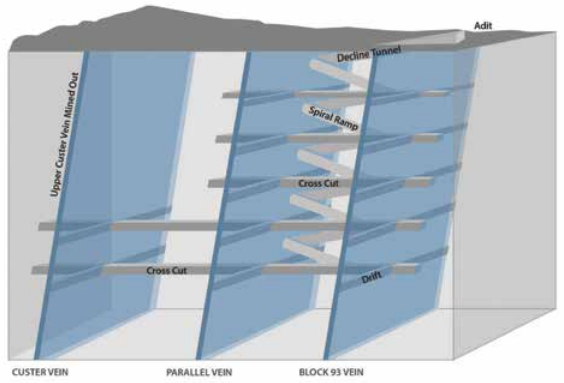October 31, 2019 -- InvestorsHub NewsWire -- via Resource World
Magazine -- After a recent injection of $1.6 million into its
coffers, Winston Gold Corp. [
WGC-CSE;
WGMCF-OTCQB] is now breaking ground to advance
two underground access tunnels to continue to explore its
wholly-owned historic Winston Gold Mine in Montana.
The high-grade, past producing Winston gold mine is located just 37
km southeast of Helena, and is easily accessible by paved highway.
What is becoming clear about this company is the fact that it has
the potential to restart mining operations quickly and with minimal
upfront capital.
The Custer Vein was mined sporadically between 1930 and 1955.
High-grade gold mineralization was mined along strike for over
2,400 feet (732 metres) on five primary levels and reports estimate
that only limited mining was performed below the water table which
is situated at the 400 foot level (4,180 feet elevation).
Over the past few years, Winston Gold completed several drill
programs that not only confirmed and expanded mineralized zones
below the known workings of the Custer Vein but also delineated two
additional, near surface, vein systems known as the Parallel and
the Block 93 veins.
The company's plan is to access and test mine the shallower
Parallel and Block 93 vein systems. At the same time Winston
intends to access and rehabilitate the old upper-level workings of
the Custer Mine and sample the margins of the Custer vein for
potentially economic gold mineralization.
The first tunnel, now dubbed Carrabba, is a brand-new access tunnel
that is expected to extend for a total of 900 feet (274 metres) at
a 1% grade and provide access to the high-grade gold mineralization
identified in the Block 93 and Parallel veins. It is also
anticipated to provide access into the historic Custer workings at
the uppermost level of the old Custer Mine.
The second access tunnel, named Tunnel #1, is located about 1,500
feet (or 457 metres) to the northwest of the Carrabba portal.
Tunnel #1 is a historic tunnel that will be widened and
rehabilitated. It will access the old Custer workings about 1,000
feet (304 metres) northeast of where the Carrabba tunnel will break
into the workings on the same level. Tunnel #1 was last used in the
late 1970s and early 1980s to access the Custer workings to mine
out sections of the vein to the surface. Tunnel #1 will not only
provide free airflow for ventilation but also a necessary secondary
escape way when test-mining of the Parallel and Block 93 veins
commences. The secondary access will also provide Winston Gold with
the opportunity to drill test the northeastern extension of the
Parallel vein as well as test for any additional unknown vein
systems in this area.

A three-dimensional representation of existing and proposed
underground workings at the historic Winston gold mine near Helena,
Montana. Illustration courtesy Winston Gold Corp.
Winston holds an active Exploration License that allows for
exploration drilling, mine dewatering and development as well as a
10,000-ton bulk sample for metallurgical testing. This can be
easily upgraded to a Small Miners Permit which allows for mining
provided no more than 5 acres of surface area is disturbed.
Ultimately the goal will be to reach the deeper and untouched
levels of the goldrich Custer vein. The Custer was developed to the
600 level, but the last known stoping was on the 500 level.
Recently, Joseph Carrabba took on the role of Executive Chairman of
Winston Gold. This, in our opinion, is another significant
endorsement of the potential of this project. Carrabba has over 42
years of management and operational experience in the resource
industry. He has stated that he believes in the potential of the
highgrade Winston gold project and intends to work towards
transforming that potential into reality.
Having formerly served as President and Chief Operating Officer of
Cliffs Natural Resources Inc., President and Chief Operating
Officer of Diavik Diamond Mines, Inc. and General Manager of Weipa
Bauxite Operation of Comalco Aluminum, we believe Carrabba’s
opinion carries some weight. He has put his money where his mouth
is and currently owns about 25% of the fully diluted shares of
Winston Gold Corp.
Stew Vorberg and Doug Wood are Investment Advisors with Mackie
Research Capital Corporation (MRCC). This article was prepared, in
part, under contract by Thomas Schuster. The opinions, estimates
and projections herein are those of the authors and may not reflect
that of MRCC. The information and opinions contained herein have
been compiled and derived from sources believed to be reliable, but
no representation or warranty, expressed or implied, is made as to
their accuracy or completeness. The issuer(s) mentioned in this
article may not be suitable for all investors. Please consult an
investment professional for advice regarding your particular
circumstance. Neither the author nor MRCC accepts liability
whatsoever for any loss arising from any use of this article or its
contents. Information may be available to MRCC which is not
reflected herein. This article is not to be construed as an offer
to sell or a solicitation for an offer to buy any securities. The
information contained in this article is not intended to constitute
a research report. Stew Vorberg and Doug Wood are beneficial owners
of the company highlighted in this article.



